The Indoor Mall No Longer Retail King
In the St. Louis region a number of once bustling malls are gone or are on life support, let’s take a look at some examples.
St. Louis Centre
In the 1980s St. Louis Centre was a briefly-popular mall downtown, now it’s a parking garage with sidewalk-facing retail.
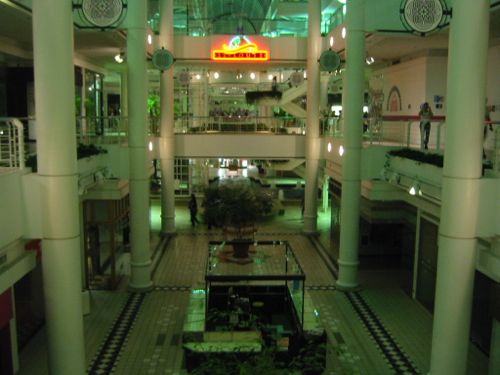
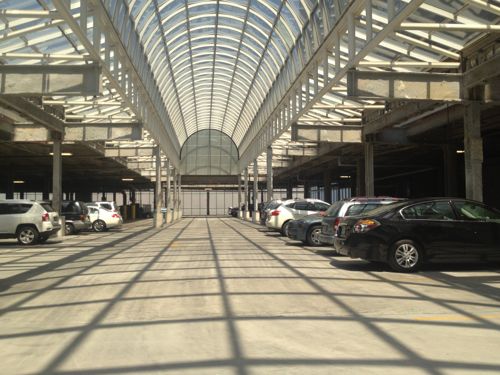
Union Station
Union Station came online at the same time, but the retail aspect faded after a few years. The new owner plans to use the former retail area for meeting/convention space.
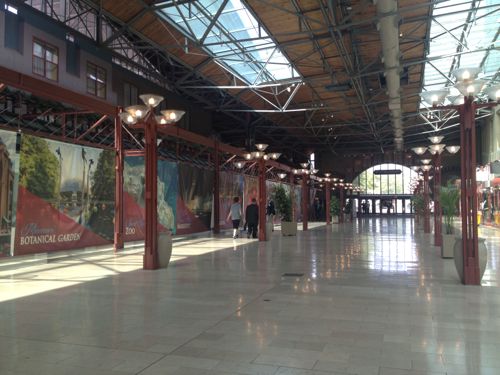
Jamestown Mall
Jamestown Mall in North County is still open, though it was closed twice this winter due to low indoor temperature.
After nearly a three-week closure, Jamestown Mall reopened on Friday.
The mall was shut down on December 20 because parts of the building were not properly heated.
The closure did not affect Macy’s, Sears Tire and Auto Center, JC Penney or Dillard’s. (Fox2)
This mall has been on life support for years, in 2011 there was talk of razing most of the mall and building a New Urbanist village on the site.
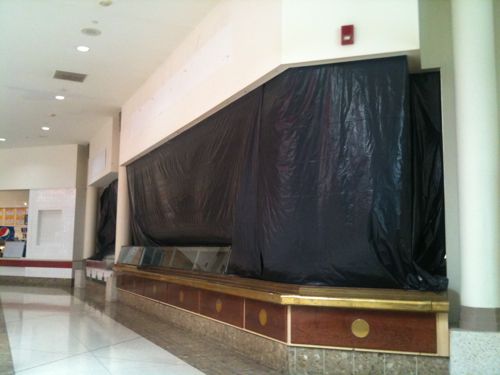
Northwest Plaza
Originally built as an outdoor mall, enclosed later, finally closed and is being replaced:
The crowds and stores were long gone. Northwest Plaza, once billed as the world’s largest shopping center, stood decaying at one of the busiest intersections in metro St. Louis, done in by new malls in more upscale areas.
Brothers Robert and P. David Glarner announced plans to buy the mall at Lindbergh Boulevard and St. Charles Rock Road and began seeking tax money for most of the redevelopment costs — nearly $50 million. (stltoday)
The site will be known as The Crossings at Northwest.
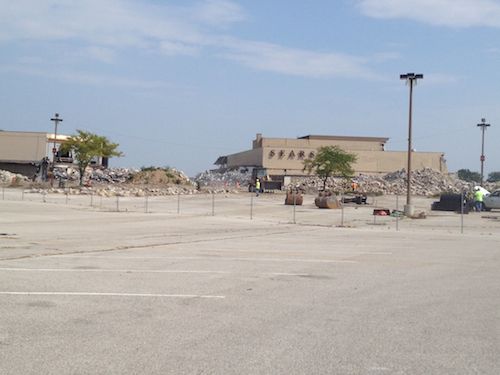
River Roads Mall
River Roads Mall was razed but only the edges of the site have seen new development. See Former River Roads Mall Site Vacant, the Few New Buildings Aren’t Pedestrian Friendly
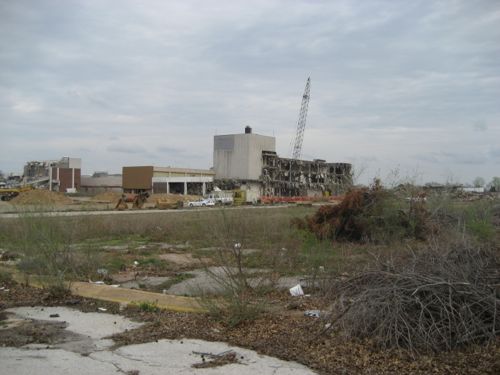
Crestwood Mall
Crestwood Mall, later renamed Crestwood Court, closed in July 2013:
It’s been more than a year since Chicago-based developer Centrum Partners LLC introduced plans to convert the dilapidated Crestwood Court mall into an entertainment plaza.
A couple of barricades and piecemeal auctions of mall fixtures have been the only sign of activity in Centrum’s $121.3 million redevelopment plan. That changes tonight, when the St. Louis area’s oldest mall officially closes its doors to the public for the last time. (stltoday)
As far as I know redevelopment plans have stalled. For a few years the mall spaces were leased for local artists at little to no rent.
West County Center
This mall opened in 1969, blighted & razed in 2001, reopened in 2002. Since then a department store was razed and a new outdoor-focused entry was built that includes restaurants and a bookstore. Inside the original high standards from 2002 have been lowered.
And my childhood mall in Oklahoma City:
Forty years ago today Crossroads Mall opened not far from my house, it was the largest mall in Oklahoma.
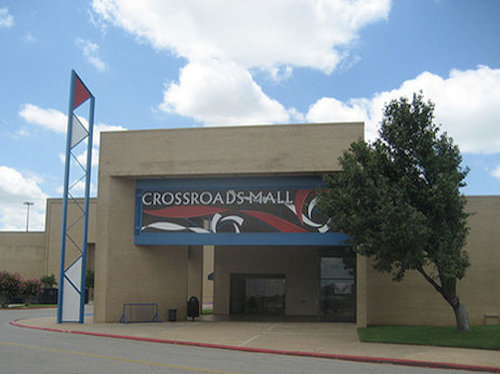
When I visited in August 2009 all four anchor department stores had closed and many interior spaces were vacant. In 2010 NPR’s All Things Considered did a story on the mall, using my image with permission. See Why The Fed Owns A Mall In Oklahoma City.
At the time I thought Crossroads was dead. Crossroads was sold and the new owners have renamed it Plaza Mayor at the Crossroads. Their concept is a focus on the hispanic population:
OKLAHOMA CITY, Oklahoma (April 25, 2013) – Something big is happening at Crossroads Mall in Oklahoma City, and it may not be what you think. When new owners, Raptor Properties bought the mall in late 2011, the most likely scenario was complete demolition. Luckily for Oklahoma, this original plan has taken a complete 180, and Raptor has partnered with The Legaspi Company to convert Crossroads Mall into Plaza Mayor at the Crossroads.
The change in paradigm will not attempt to resuscitate this mall into its original form, but rather re-imagine a new vision to take advantage of changing demographics. The partnership has unveiled its new plans to convert Crossroads Mall into the nation’s newest Hispanic cultural and commercial center. This has been a successful model, now seen all over the United States in such markets as Atlanta, Phoenix, Los Angeles and Fort Worth with similar properties.
The driving force behind many of these successful implementations has been California-based realty firm, The Legaspi Company. Raptor Properties has brought that experience and success to Oklahoma by partnering with this firm to oversee the implementation here in Oklahoma City.
Instead of relying on big department stores as the driving force behind traffic, the establishment of a cultural center with weekly programming now becomes one of the first building blocks in bringing families back to the property. This is good news to many cultural and arts organizations constantly struggling to find ways to deliver these types of programs to an under-served population. It is also good news to the Hispanic community seeking opportunities to teach their children more about their cultural heritage. Pilot events since last August have already resulted in a positive response. Each event has produced an average of 2-3 thousand patrons.
Sunday, March 31st, was no exception as the building will be hosted a 10,000-egg Easter Hunt for Hispanic families. The event sponsored by Homeland and Tyler Media was host to over 5000 people. That date also marked the official start of weekly cultural programming, featuring the state’s largest mariachi, Mariachi Orgullo de America.
On March 27th, Raptor announced the acquisition of the building that previously held Dillard’s to house a key element of this new model, the Mercardo. The Mercardo will be a 200+ vendor marketplace designed to serve as a business incubator, offering accessible retail space to a wide variety of products and services.
Other elements that will make the center a new home for Hispanic families will include many commodities focused on the comfort and entertainment of the oldest to the youngest members of these families. Such commodities include increased restroom capacity, increased soft seating including lounges, more restaurants, more play areas and kid’s activities, community services, a health services, financial services, and other non-traditional offerings that would seem out of place in mainstream malls.
Plans unveiled yesterday included architectural rendering of new entrances, a performing arts center, the retail business incubator, and other proposed uses. The hope is that Plaza Mayor will join the list of successful implementations throughout the country, and it is well on its way with 15 new contracts signed since the end of March, and increasing interest from additional national tenants.
From what I’ve seen online this strategy is working. I hope to see in person on a future visit to Oklahoma City.
— Steve Patterson
Perhaps it’s just me, but when I’m looking to do my shopping at a brick and mortar, I actually prefer malls to these “commons” which seem to be all the rage these days. In my mind the common does nothing well for the consumer.
Pedestrian access is abysmal (the entrance to EVERY store is on the other side of a main traffic lane), forcing me to drive to each store or battle it out with the cars (or like with Boone Crossing – you need to drive because it is 2 miles long). In a place like STL, which is very hot in the summer and relatively cold in the winter, I’m left to bake/freeze running between each store across the stark football field parking lot. Not to mention constantly getting rained on, snowed on, hailed on, etc, etc. The usual common also has far less stores than your typical mall, so now I have to drive to 3 other common developments.
Don’t get me wrong, I HATE malls. I’d rather do all my shopping in downtown Maplewood or Webster, but as far as a one-stop experience goes, I think we have actually taken a step backwards.
Usually subdividing bigger stores into smaller, internal, vendor spaces is the last step before the whole thing shuts down – see pretty much any “antique mall” or “flea market”. In the case of OKC, focusing on the Hispanic market depends completely on local demographics and supply and demand – if the market is there and the numbers make sense, it could work. But to expect something like 10% of the population to support a mall that was once supported by 100% of the population is usually an exercise in delusional optimism. Something similar was tried at Crestwood Court, with an arts focus, but only lasted a couple of years.
And I agree with Ryley – our weather plays a role in how people shop around here. We’re not the sun belt, and walking around on many days can be pretty unpleasant. Combine that with how shopping continues to evolve, with online everything and big boxes offering both big selections and cheap prices, and it’s not surprising that traditional malls are struggling. But the other part of the equation is where we each are in our own life cycles – shoppers in their teens have different priorities than those in their 20’s, 30’s, 40’s, 50’s, 60’s and older, as do each of the other groups. Change happens – embrace it!
Steve, I overall agree with your premise in this post, but West County is not in any stretch of the imagination “going down hill.” Likewise, you ignore South County Center, St. Clair Square and Chesterfield Mall, which are all doing perfectly fine. I would even say South County Mall is thriving.
When West County was rebuilt, after being blighted in a pricey zip code, they had very strict design standards. They’ve clearly tossed those out the window! The corridors are filled with tacky kiosks. But most likely it’ll be able to maintain this level and not go down any further.
The point of the post was to show in the past indoor malls was king, many were built. I say they were overbuilt. When was the last mall built in our region? Rebuilt West County in 2002 and St. Louis Outlet (Mills) opened in 2003.
I clearly need stronger meds. I see myself agreeing with Steve on the overall post. I notice the lack of comparison of the Galleria, Chesterfield and the others that are doing well…reinventing themselves to the market. The kiosks are just making sure every square inch of space is pulling in $$$$…no different than sidewalk vendors in Times Square which leads to Ryley’s post….our weather is too unpredictable for strolling between shops outdoors from one day to the next. I’ve been to the Biltmore and other outdoor ‘malls’ and the weather plays a big part in their success.
Having said that…this does not mention the original thought process…all malls were destinations. Many communities owed their life blood to them….not from sales tax dollars (that too, but to a lesser degree) but from destination being in…let’s move closer. At one time Chesterfield Mall was built in the woods, and what was that mall at 70/64/40 interchange that is now gone? And Crestwood Mall, as well as the others, were built at the height of the great migration…of an earlier generation. Now these areas are all filled in. The only new residential construction is tear and rebuild…add to that the rise of TIFFs, more polarization of towns (ie….Kirkwoodians would be insulted to be called a Webster and vice versa) and their wanting more and more tax dollars (while giving them away at the backdoor through those same TIFFs)….and you have what we have today. Cannibalization. And what retailer wants to get locked in for years with other large retailers? Too unpredictable in today’s ever changing economy. They want to be able to close and move just as the people move.
Big malls are a thing of the past, unless they’re true destination malls like Mall of America, and there aren’t many of them (and I wonder how they are doing ). Now the draw is Big Box-semi mall with a few smaller stores tucked in their shadow (not competing of course, that would be taboo)…and perhaps we’ll live to see their popularity wane as well.
But be it Mall of America, Big Box, or mom n’ pop….none will make it if we always buy on-line. Saving a few dollars is one thing, but we can’t save dollars and complain of the lack of retail, especially small stores. They are not compatible.
One big challenge is that most malls seem to all have the same chain stores – Victoria’s Secret, Build A Bear, Pac Sun, Orange Julius, etc. – and many of them are no longer as relevant to as many shoppers as they used to be. Plus, even chain stores vary their merchandise selections, by individual stores, based on past buying patterns, so the strong get stronger and the mediocre stay mediocre or, worse, slowly decline. But I’ll argue that online shopping is having the biggest effect on the decline of the traditional mall, since, unlike big boxes (which are mainly focused on staples), malls focus on people browsing, which is done more easily, these days, at sites like Amazon and ebay and all the online sites that brick-and-mortar stores all now have.
I’d love to see many of these dead malls replaced with New Urbanist infill (ala BelMar in Denver) but I doubt anything like will happen in St. Louis. The North County malls will likely remain empty lots or get haphazard auto-centric infill. Nobody wants to put any money into NoCo and a large New Urbanist project is EXPENSIVE. The only hope for redevelopment was Crestwood but it looks like that’s not going to happen. There’s real potential to build an actual downtown/center for Crestwood there but they’re afraid of change. Also, I suspect afraid of anything “urban” that includes higher density and rental units/mixed use for fear it will attract the “wrong sort of people”.